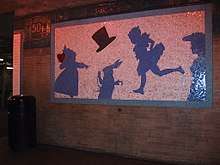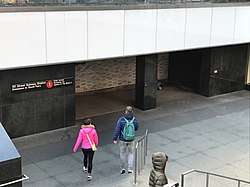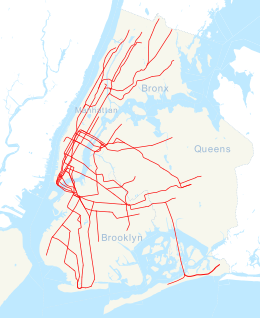50th Street station (IRT Broadway–Seventh Avenue Line)
50th Street is a local station on the IRT Broadway–Seventh Avenue Line of the New York City Subway. Located at the intersection of 50th Street and Broadway at the northwest corner of the Theater District, it is served by the 1 train at all times and by the 2 train during late nights.
50 Street | |||||||||
|---|---|---|---|---|---|---|---|---|---|
Downtown platform | |||||||||
| Station statistics | |||||||||
| Address | West 50th Street & Broadway New York, NY 10019 | ||||||||
| Borough | Manhattan | ||||||||
| Locale | Midtown Manhattan | ||||||||
| Coordinates | 40.761°N 73.984°W | ||||||||
| Division | A (IRT) | ||||||||
| Line | IRT Broadway–Seventh Avenue Line | ||||||||
| Services | 1 2 | ||||||||
| Transit connections | |||||||||
| Structure | Underground | ||||||||
| Platforms | 2 side platforms | ||||||||
| Tracks | 4 | ||||||||
| Other information | |||||||||
| Opened | October 27, 1904[1] | ||||||||
| Station code | 316[2] | ||||||||
| Wireless service | |||||||||
| Opposite-direction transfer available | No | ||||||||
| Traffic | |||||||||
| Passengers (2019) | 8,134,360[4] | ||||||||
| Rank | 41 out of 424[4] | ||||||||
| Station succession | |||||||||
| Next north | 59th Street–Columbus Circle: 1 | ||||||||
| Next south | Times Square–42nd Street: 1 Times Square (shuttle): no passenger service | ||||||||
| |||||||||
| |||||||||
| |||||||||
History
Operation of the first subway began on October 27, 1904, with the opening of the original 28 stations of the New York City Subway from City Hall to 145th Street on the West Side Branch including the 50th Street station.[5]:162–191[6]
In 1981, the MTA listed the station among the 69 most deteriorated stations in the subway system.[7]
On September 7, 1987, Alex Cumba fell onto the tracks of the 50th Street station.[8] Bystanders Edwin Ortiz, Jeff Kuhn, and Melvin Shadd jumped onto the tracks and attempted to lift Cumba back onto the platform, which was difficult due to Cumba's weight. The three were able to remove Cumba seconds before the train arrived. A recreation of the story aired on Rescue 911 on September 17, 1991.[9][10]
Station layout
| G | Street level | Exit/entrance |
| P Platform level |
Side platform | |
| Northbound local | ← ← | |
| Northbound express | ← | |
| Southbound express | | |
| Southbound local | | |
| Side platform | ||


This underground station has four tracks with two side platforms.[11] The two express tracks are used by the 2 train during daytime hours and the 3 train at all times. Original tile plaques at this station were removed during remodeling, but one of them has been preserved at the New York Transit Museum.
The station contains the artwork Liliana Porter's Alice, The Way Out, a series of mosaics installed in 1994 depicting characters from Lewis Carroll's Alice in Wonderland. [12]
Exits
Each platform has same-level fare control at the center and there are no crossovers or crossunders to allow free transfer between directions. Each fare control area has a token booth, turnstile bank, and newsstand. The northbound has four staircases to the streets: two to the northeast corner of 50th Street and Broadway, one to the southeast corner, and one inside a building on the south side of 50th Street midblock between Broadway and 7th Avenue. The southbound platform has an exit to an underground shopping arcade on the south side of 50th Street west of Broadway, and another to the southern sunken courtyard of Paramount Plaza on the northwest corner of 50th Street and Broadway.[13]
References
- "Our Subway Open: 150,000 Try It; Mayor McClellan Runs the First Official Train". The New York Times. October 28, 1904. p. 1. ISSN 0362-4331. Retrieved April 21, 2020.
- "Station Developers' Information". Metropolitan Transportation Authority. Retrieved June 13, 2017.
- "NYC Subway Wireless – Active Stations". Transit Wireless Wifi. Retrieved November 13, 2019.
- "Facts and Figures: Annual Subway Ridership 2014–2019". Metropolitan Transportation Authority. 2020. Retrieved May 26, 2020.
- Walker, James Blaine (1918). Fifty Years of Rapid Transit — 1864 to 1917. New York, N.Y.: Law Printing. Retrieved November 6, 2016.
- "Subway Opening To-day With Simple Ceremony – Exercises at One O'Clock – Public to be Admitted at Seven – John Hay May Be Present – Expected to Represent the Federal Government – President Roosevelt Sends Letter of Regret" (PDF). The New York Times. October 27, 1904. ISSN 0362-4331. Retrieved May 28, 2017.
- Gargan, Edward A. (June 11, 1981). "Agency Lists Its 69 Most Deteriorated Subway Stations". The New York Times. Retrieved August 13, 2016.
- "3 Rescue Unconscious Man From Subway Tracks". The New York Times. 1987-09-06.
- Rescue 911 Episode Guide - Rescue 911 Season Episodes - TV.com
- "3 Men Rescue Unconscious Man From Subway Tracks". The New York Times. September 6, 1987. Retrieved June 30, 2010.
- Dougherty, Peter (2006) [2002]. Tracks of the New York City Subway 2006 (3rd ed.). Dougherty. OCLC 49777633 – via Google Books.
- "Arts for Transit and Urban Design". mta.info. Metropolitan Transportation Authority. Retrieved October 20, 2012.
- "MTA Neighborhood Maps: Midtown West" (PDF). mta.info. Metropolitan Transportation Authority. 2015. Retrieved December 11, 2015.
External links
| Wikimedia Commons has media related to 50th Street (IRT Broadway – Seventh Avenue Line). |
- nycsubway.org – IRT West Side Line: 50th Street
- nycsubway.org – Alice: The Way Out Artwork by Liliana Porter (1994)
- Station Reporter – 1 Train
- Forgotten NY – Original 28 - NYC's First 28 Subway Stations
- MTA's Arts For Transit – 50th Street (IRT Broadway–Seventh Avenue Line)
- 50th Street entrance (Downtown) from Google Maps Street View
- 50th Street entrance (Uptown and The Bronx) from Google Maps Street View
- 50th Street and Broadway entrance from Google Maps Street View
- Platforms from Google Maps Street View



%26groups%3D_a484a2b09e6c1a08ab963081348d625b1eb2b5b6.svg)